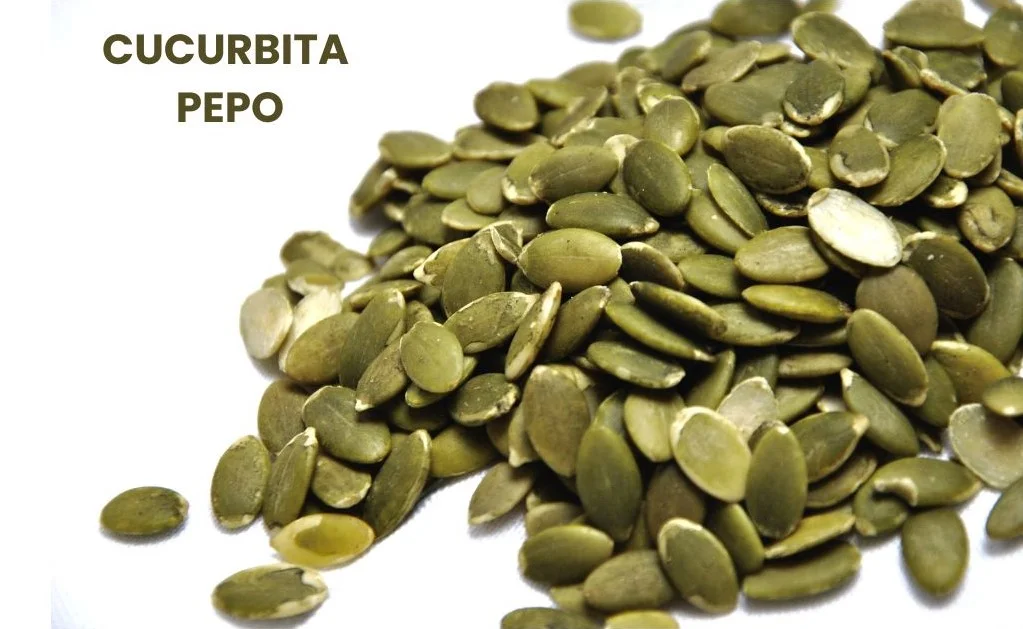Cucurbita pepo, commonly known as pumpkin seed, is a medicinal remedy derived from the seeds of the pumpkin plant.
It is used primarily for its effectiveness in treating conditions such as intense nausea, vomiting of pregnancy, seasickness, and as a teniafuge, meaning it expels tapeworms from the body.

Table of Contents
ToggleSOURCE INFORMATION
Scientific Classification
- Kingdom: Plantae
- Order: Cucurbitales
- Family: Cucurbitaceae
- Genus: Cucurbita
- Species: Cucurbita pepo
Origin
- The pumpkin, scientifically known as Cucurbita pepo, is believed to have originated in North America, particularly in Mexico.
- It has been cultivated for thousands of years by indigenous peoples in the region.
Historical Significance
- Pumpkins have a rich history of culinary and medicinal use. Indigenous peoples of the Americas, such as the Aztecs and the Mayans, cultivated and consumed pumpkins as a staple food source.
- They also recognized the medicinal properties of pumpkin seeds, using them to treat various ailments.
Cultural Importance
- Pumpkins hold significant cultural importance in various societies.
- They are often associated with fall harvest festivals, such as Halloween and Thanksgiving, where they are used for decorative purposes and as ingredients in traditional dishes.
Botanical Description
- Cucurbita pepo is a species of squash that belongs to the Cucurbitaceae family. It is a trailing vine with large, lobed leaves and yellow flowers.
- The fruit of the plant, commonly known as a pumpkin, varies in size, shape, and color, ranging from small and round to large and elongated.
- Pumpkins typically have a thick, orange or yellow outer rind and contain numerous seeds embedded in fibrous flesh.
Culinary Use
- Pumpkins are widely utilized in cooking for their sweet, nutty flavour and versatile nature.
- They can be roasted, boiled, baked, or pureed to make soups, pies, bread, and other dishes.
- Pumpkin seeds are often roasted and eaten as a nutritious snack or used as a garnish in salads and other recipes.
Medicinal Properties
- Pumpkin seeds have been used in traditional medicine for their various health benefits.
- They are rich in nutrients such as protein, fibre, vitamins, and minerals, and are believed to possess anti-inflammatory, antioxidant, and anthelmintic (anti-parasitic) properties.
- Pumpkin seed extracts and oils are used in herbal remedies to support prostate health, promote urinary tract function, and expel intestinal parasites, including tapeworms.
Commercial Use
- In addition to their culinary and medicinal applications, pumpkins and pumpkin seeds are utilized in various commercial products.
- Pumpkin seed oil is extracted and used in cosmetics, skincare products, and culinary oils.
- Pumpkin seeds are also processed into snacks, breakfast cereals, and dietary supplements.
DRUG PATHOGENESIS
- Pumpkin seed acts as a teniafuge, meaning it expels tapeworms from the body.
- It also helps alleviate intense nausea, vomiting of pregnancy, and seasickness.
KEY CHARACTERISTICS
- Effective in treating intense nausea immediately after eating.
- Useful for vomiting of pregnancy.
- Helpful for seasickness.
- Known as one of the most efficient and least harmful teniafuges, meaning it helps expel tapeworms from the body.
RELATIONSHIP
- Compare with Filix and Cuprum oxid nig.
DOSE
The dosage instructions for pumpkin seed as a remedy for tapeworm are as follows:
- Prepare a tincture of pumpkin seed.
- Scald the seeds and peel off the outer skins when they have softened, leaving only the green inner pulp.
- Take two ounces of seeds, which will yield one ounce of pulp.
- Mix the pulp with cream and consume it like porridge.
- Take the pumpkin seed mixture in the morning after fasting for twelve hours.
- Follow the pumpkin seed mixture with castor oil two hours later.
This dosing regimen is designed to effectively expel tapeworms from the body.
Frequently Asked Questions
What is pumpkin seed used for?
- Pumpkin seed is used to alleviate intense nausea, vomiting of pregnancy, seasickness, and as a teniafuge to expel tapeworms from the body.
How should pumpkin seed be prepared and taken?
- The seeds should be scalded and the outer skins peeled off when softened.
- The green inner pulp is the part used.
- It can be mixed with cream and taken like porridge.
- It should be taken in the morning after twelve hours of fasting, followed by castor oil two hours later.
Meaning of Difficult Words
- Teniafuge: A substance that expels tapeworms from the body.
- Cucurbitaceae: The plant family to which pumpkin belongs.
- Nausea: A feeling of sickness with an inclination to vomit.
- Seasickness: Motion sickness experienced when traveling on the sea.
- Tincture: A solution of a medicinal substance in alcohol.
- Scalded: Subjected to boiling water or steam.
- Porridge: A soft food made by boiling ground grains, typically oats, in water or milk.
